Model to Assess the Quality of Magmatic Rocks for Reliable and Sustainable Constructions
Abstract
:1. Introduction
2. Geology of Southern Apuseni Mountains
3. Characterization of Studied Magmatic Rocks from South Apuseni
3.1. Mineralogical and Petrographical Characterization of Igneous Rocks Analyzed
3.2. Chemical Composition of Magmatic Rocks Analyzed
- To determine the reduction of sodium hydroxide solution Rc, Equation (1) was used:where Rc represents the reduction of the concentration of sodium hydroxide solution, in mmol/dm3; f is the factor of chlorhydric acid utilized during titration 0.05 n; V2 is the volume of chlorhydric acid 0.05 n utilized for titration of analyzed sample in cm3; V3 is the volume of chlorhydric acid 0.05 n utilized for titration of witness sample, in cm3; and V1 is the volume of diluted solution, in cm3 (20 cm3).
- The quantity of silica dioxide from the filtered sodium hydroxide solution was determined with Equation (2):where: Sc is the concentration of dissolved silica dioxide in mmol/dm3; A1 is the concentration of silica dioxide in g, in 100 cm3 diluted solution; A2 is the concentration of silica dioxide in g, in 100 cm3 witness solution, diluted; and 60.06 is the molecular mass of silica dioxide, in g.
3.3. Physical and Resistance Properties of Magmatic Rocks
3.4. Admissibility Condition of Rocks Based on Provenance
4. Assessment Methodology of Rocks
5. Results and Discussion
- Gabbro is homogenous rock from the perspective of structure and mineralogical–petrographical composition, without visible traces of physical and chemical degradation; apparent density of 2.844 × 103 kg/m3; value of porosity (1.516%) leading to rock classification as “less porous”; a small difference between specific density and apparent density lead to significant compaction of the rock, with an average of 98.483%; water absorption is directly influenced by porosity an average of 0.427% leading to the classification of the rock as “least absorbent”; from the perspective of resistance to breakage due to monoaxial compression, the rock is classified as having “high resistance”.
- Diabase is homogenous rock from the perspective of structure and mineralogical–petrographical composition, without visible traces of alteration, despite a system of millimeter fissures colmated with carbonates; volumetric density of 2.7823–2.7876 g/cm3, with an average of 2.749 g/cm3, leading to rock classification as “heavy”; 1.267% porosity, leading to rock classification as “least porous”; compaction of 98.732%; water absorption of 0.69%, leading to the classification of the rock as “least absorbent”; from the perspective of resistance to breakage due to monoaxial compression, the rock is classified as being “resistant”.
- Granite is homogenous rock from the perspective of structure and mineralogical–petrographical composition, without visible traces of alteration; volumetric density of the three granite types are 2.619–2.625 g/cm3, leading to rock classification as “heavy”; porosity of 0.58–0.82% leading to rock classification as “less porous”; water absorption from 0.29% to 0.31%, leading to the classification of the rock as “less absorbent”; compaction from 99.17% to 99.41% is regarded as high; mechanical resistance is considered very high.
- Diorite is homogenous rock from the point of view of structure and mineralogical–petrographical composition, without visible traces of alteration; volumetric density of 2.95 g/cm3, leading to rock classification as “heavy”; porosity of 0.45% leading to rock classification as “less porous”; rock resistance is considered high.
- Rhyolite has various alteration states; following alteration, the volumetric density is relatively low, however the rock is still classified as “heavy”; porosity is high, as a result of the differences between the values of volumetric density and apparent density; water absorption leading to the rock classification as “less absorbent”; porosity influences the compaction, which is 96.89%; mechanical resistance is considered low.
- There are six types of andesites, with the following properties: various alteration states, from incipient to advanced; based on the alteration states, the volumetric density varies accordingly between 2.45–2.67 g/cm3; alteration affects porosity, which presents different values; under the influence of alteration phenomenon, compaction presents values of 95.62–99.26%; rock moisture varies between 0.64–2.76%; monoaxial compressive strength is 110.19–143.53 MPa.
- There are two types of basalts characterized as follows: no alteration visible, leading to a homogenous structure; volumetric density of 2.69–2.70 g/cm3; relatively low porosity, 0.89–0.93%; reduced absorption, at 1.23–1.33%; water saturation is 0.62–0.67 leading to rock classification as “moist”; based on their mechanical resistance, these are considered “very hard rocks”; based on deformation property, the rock presents an elastic behavior. For each of the 15 types of rocks analyzed, applying the methodology proposed the conformity level, safety level and unconformity degree were determined. The results are given in Table 10.
6. Conclusions
Author Contributions
Conflicts of Interest
References
- Renard, M.; Lagabrielle, Y.; Martin, E.; Rafelis, M. Eléments de Géologie, 15th ed.; Edition du POMEROL; Dunod Publishing House: Paris, France, 2015. [Google Scholar]
- Toderaş, M. Tests on Materials; Focus Publishing House: Petroşani, Romania, 2008; p. 440. ISBN 978-973-677-141-5. (In Romanian) [Google Scholar]
- Danciu, C. Geomechanics of Magmatites from South Apuseni; Universitas Publishing House: Petroşani, Romania, 2010. (In Romanian) [Google Scholar]
- Tiess, G.; Chalkiopoulou, F. Sustainable Management of Aggregates Resources and Sustainable Procurement Combined at Regional/National and Transnational Level; Technical University of Crete: Chania, Greece, 2011. (In Romanian) [Google Scholar]
- Beauchamp, J. Les Roches Propriétés et Utilisation; Université de Picardie Jules Verne: Amiens, France, 2003. [Google Scholar]
- Ivascu, L.; Cioca, L.I. Opportunity Risk: Integrated Approach to Risk Management for Creating Enterprise Opportunities. Adv. Educ. Res. 2014, 49, 77–80. [Google Scholar]
- Ielenicz, M.; Patru, I.; Ghincea, M. Romania’s Sub-Carpathians; Universitară Publishing House: Bucureşti, Romania, 2003. (In Romanian) [Google Scholar]
- Irimuş, I.A. Physical Geography of Romania I; Casa Cărţii de Ştiinţă Publishing House: Cluj-Napoca, Romania, 2003. (In Romanian) [Google Scholar]
- Velcea, V.; Savu, A. Geografia Carpaţilor şi a Subcarpaţilor Româneşti; Didactică şi Pedagogică Publishing House: Bucureşti, Romania, 1982. (In Romanian) [Google Scholar]
- Mutihac, V. Geologic Structure of Romanian Territory; Tehnică Publishing House: Bucureşti, Romania, 1990. (In Romanian) [Google Scholar]
- Cioca, L.-I.; Moraru, R.I.; Babut, G.B. A Framework for Organisational Characteristic Assessment and Their Influences on Safety and Health at Work; Book Series: Knowledge Based Organization International Conference; Land Forces Academy: Sibiu, Romania, 2009; Volume 2, pp. 43–48. [Google Scholar]
- Săndulescu, M. Geotectonics of Romania; Tehnică Publishing House: Bucureşti, Romania, 1984. (In Romanian) [Google Scholar]
- Boillot, G.; Huchon, P.; Lagabrielle, Y. Introduction à La Géologie: La Dynamique de la Lithosphere, 4th ed.; Editura Dunod: Paris, France, 2008. [Google Scholar]
- Pomerol, C.; Renard, M.; Lagabrielle, Y. Eléments de Géologie; Dunod Publishing House: Paris, France, 2000. [Google Scholar]
- Har, N. Alpine Basaltic Andesites in Apuseni Mountains; Casa Cărţii de Ştiinţă Publishing House: Cluj-Napoca, Romania, 2001. (In Romanian) [Google Scholar]
- STAS 5440-70. In Testing the Alcalii–Aggregate Reaction; Romanian Standard: Bucharest, Romania, 1970. (In Romanian)
- Brooks, R.H.; Corey, C.T. Hydraulics Properties of Porous Media; Colorado State University: Fort Collins, CO, USA, 1964. [Google Scholar]
- SR 667/2001. In Admissibility Conditions; Romanian Standard: Bucharest, Romania, 2001. (In Romanian)
- Băbuţ, G.B.; Moraru, R.I. Occupational Health and Safety Auditing: Practical Application and Projects Guide; Universitas Publishing House: Petroşani, Romania, 2014. (In Romanian) [Google Scholar]
- Cioca, L.-I.; Ivascu, L. Risk Indicators and Road Accident Analysis for the Period 2012–2016. Sustainability 2017, 9, 1530. [Google Scholar] [CrossRef]
- Ionica, A.; Leba, M. Human action quality evaluation based on fuzzy logic with application in underground coal mining. Work 2015, 51, 611–620. [Google Scholar] [CrossRef] [PubMed]
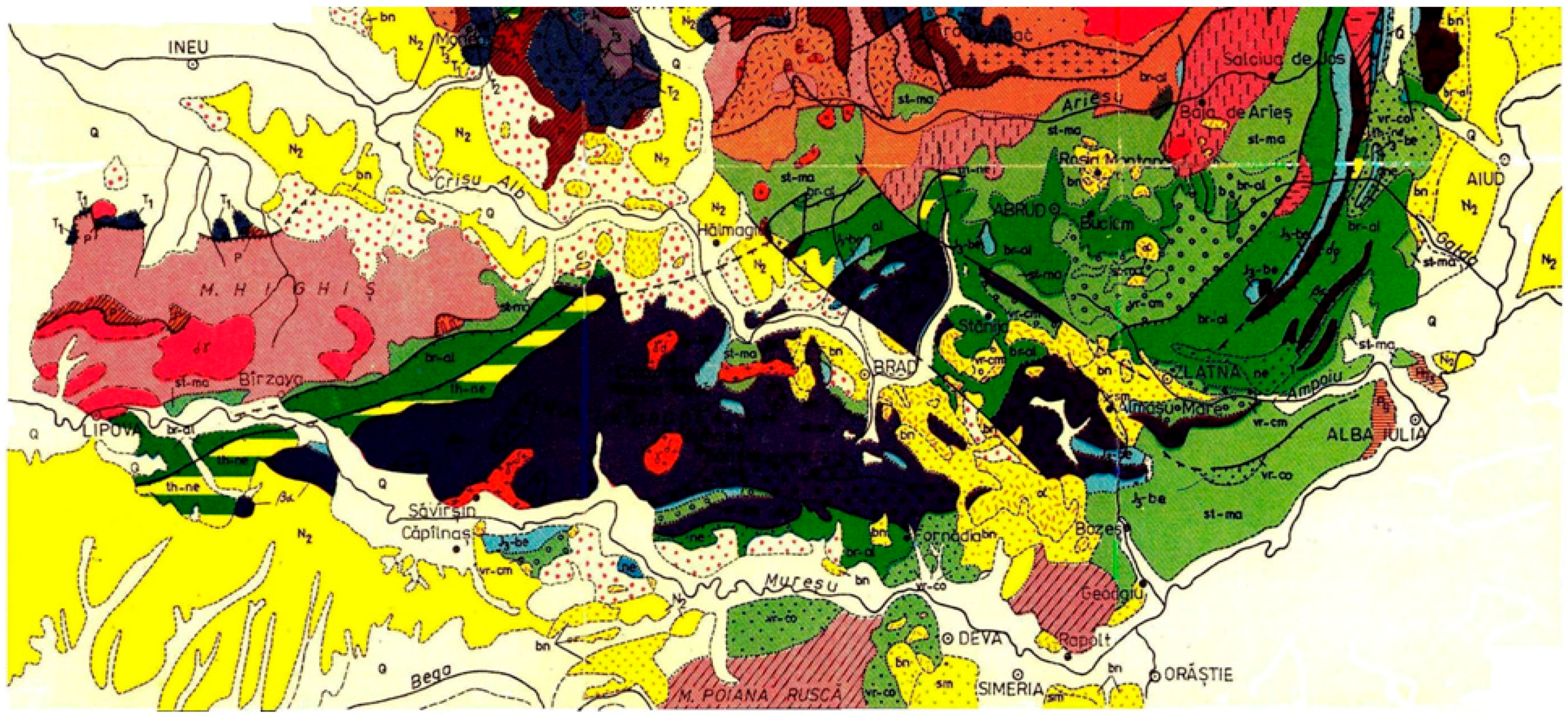

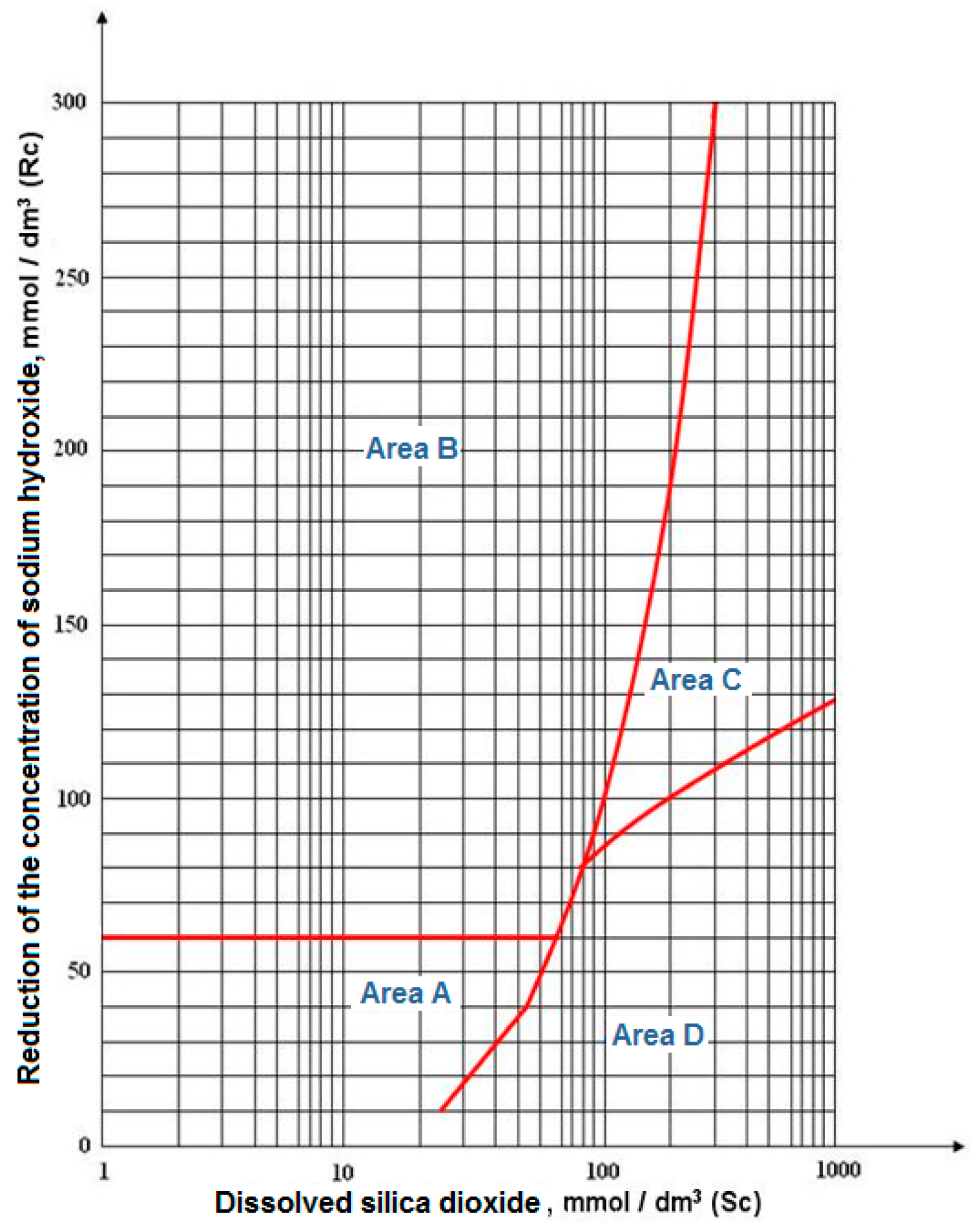
| Macroscopic Analysis | Microscopic Analysis |
|---|---|
| Şoimuş Granite—sample number 1 Sampling location: Șoimuș, Arad District. Geological structure: tardi-orogenic (Banatitic) magmatism. Rock type: magmatic, plutonic, and acidic. Rock structure: holocrystalline, granular hypidiomorphic, slightly porphyritic Rock texture: unoriented (massive), compact. Color: white-greyish, with slight pink hue. Mineralogical composition: quartz, orthoclase and plagioclase feldspars, biotite, secondary minerals. Reaction to acids: none of the rock components reacts with dilute HCl  Granite | Structure: holocrystalline, hypidiomorphic-granular, porphyritic. Rock texture: unoriented (massive), compact. Mineralogical composition; quartz, orthose, plagioclase feldspar, biotite, opaque minerals, sericite, kaolinite. Quartz: (32.5%) appears as crystals with non-geometric, xenomorphic contours and variable dimensions, between 0.2/0.1 mm and 2.3/1.8 mm. The quartz presents random feldspar inclusions, rarely intergrown with orthose and forming micrographic, myrmekitic structures. In several occurrences, the submillimeter crystals are grouped as a mosaicated arrangement. Orthose (27.3%) appears hypidiomorphic, allotriomorphic, rarely idiomorphic. Crystals’ dimensions vary between 0.3/0.2 mm and 2.7/1.7 mm. This mineral presents incipient to sometimes advanced states of mineralogical alteration. Plagioclase feldspar (26.2%) is represented by its acidic variety (albite); the crystals, mostly hypidiomorphic and rarely idiomorphic, present dimensions between 0.4/0.3 mm and 2.5/1.5 mm. Similar to the orthose, the plagioclase feldspar presents different states of mineralogical alteration. Biotite does not exceed 4.5% from all mineral components; it appears in the rock mass fresh or partially to totally limonitized. Denomination rock: Adamelitic Granite.  Plagioclase feldspar and orthoclase with equal proportions, quartz crystalized at a later stage, partially corroding the feldspar crystals |
| Şoimuş Granite—sample number 2 Sampling location: Șoimoș, Arad District. Geological structure: tardi-orogenic (Banatitic) magmatism. Rock type: magmatic, plutonic, acidic. Rock structure: holocrystalline, hypidiomorphic granular, slightly porphyroidic. Rock texture: unoriented (massive), compact. Color: white-greyish, slight pink hue, dotted. Mineralogical composition; quartz, plagioclase and orthoclase feldspar, biotite, opaque and secondary minerals. Reaction to acids: none of the rock components reacts with dilute HCl.  Porfiroid Granite | Structure: holocrystalline, granular hypidiomorphic, slightly porphyroidic. Texture: unoriented (massive), compact. Mineralogical composition; quartz, orthose, plagioclase feldspar, biotite, opaque minerals, secondary minerals. Quartz (33.2%) lacks completely geometric contour and occupies the interstices between feldspars. Quartz crystal dimensions do not exceed a maximum of 1.5 mm, with the majority of submillimeter dimensions. The quartz crystals appear as mosaicated arrangement or intergrown with orthose, as myrmekite. Orthose (37.5%) appears less frequently with geometric, idiomorphic contours, and more frequently as hypidiomorphic and xenomorphic crystals. The orthose crystals dimensions vary between 0.2/0.1 mm and 2.0/1.5 mm. The orthose presents mostly incipient states of mineralogical alteration; sporadically, advanced mineralogical alteration is also observed. Some crystal contours are corroded by finely crystallized quartz. Plagioclase feldspar (25.3%) consists of hypidiomorphic crystals of albite and oligoclase, frequently developed from average to large crystals (0.5/0.4 mm and 0.3/1.8 mm). The feldspar presents different states of mineralogical alteration, such as sericitization and kaolinization. Biotite does not exceed 4.5% from the mass of all components, appearing as fresh or partially to totally limonitized. Denomination rock: Porphyiroidic Granite.  Porphyiroidic granite. Orthose with twins (macles), phenocryst within metastasis mass of quartz and plagioclase |
| Săvârșin Granite—sample number 3 Sampling location: Săvârșin, Arad District. Geological structure: epeirogenic subsequent banatitic (laramide) magmatism. Rock type: magmatic, plutonic, and acidic. Rock structure: holocrystalline, granular hypidiomorphic, slightly porphyroidic. Rock texture: unoriented (massive), compact. Color: white-greyish, slight pink hue. Mineralogical composition: quartz, orthose, acidic plagioclase feldspars, biotite, accessory minerals. Reaction to acids: none of the rock components reacts with dilute HCl.  Săvârşin Granite | Structure: holocrystalline, hypidiomorphic-granular, partially porphyroidic. Texture: unoriented (massive), compact. Mineralogical composition; quartz, orthoclase feldspar (orthose), acid plagioclase feldspar, biotite, zircon, opaque minerals, sericite, kaolinite, limonite. Quartz (25.6%) appears as crystals with non-geometric, xenomorphic contours, and variable dimensions between 0.2/0.1 mm and 2.0/1.7 mm. Small dimension crystals are usually encountered between feldspar interstices, sometimes as a mosaicated arrangement. Orthose (33.5%) is represented by hypidiomorphic, idiomorphic, and subordinately allotriomorphic crystals. The crystals may present bisynthetic twins (macles), with dimensions varying between 0.2/0.1 mm and 2.5/1.5 mm. The orthose mineral presents fresh or incipient to advanced states of mineralogical alteration. Plagioclase feldspar (35.0%) consists mainly of hypidiomorphic and idiomorphic crystals. The plagioclase crystals present dimensions between 0.5/0.4 mm and 2.4/1.6 mm. This mineral is an acid plagioclase, slightly zoned. Similar to the orthose, the plagioclase feldspar presents various degrees of mineralogical alteration. Biotite does not exceed 4.0% from the mass of all components, appearing as fresh or partially to totally limonitized. Denomination rock: Săvârșin Granite  Banatitic granite with porphyroidic structure |
| Șoimoș Diorite—sample number 4 Sampling location: Șoimoș, Arad District. Geological structure: tardi-orogenic (Banatitic) magmatism. Rock type: magmatic, plutonic, intermediate. Rock structure: holocrystalline, granular hypidiomorphic. Rock texture: unoriented (massive), compact. Color: greyish, slightly dotted. Mineralogical composition: plagioclase feldspar, pyroxenes. Reaction to acids: none of the rock components reacts with dilute HCl. 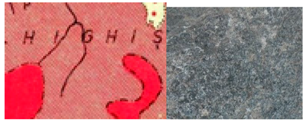 Augitic Diorite | Structure: holocrystalline, granular hypidiomorphic. Texture: unoriented (massive), compact. Mineralogical composition; intermediate plagioclase feldspar, pyroxenes (augite and diopside) biotite, quartz, opaque minerals, limonite. Plagioclase feldspar (60.0%) consists of hypidiomorphic crystals and very rarely, subordinately, idiomorphic and xenomorphic crystals. The mineral appears fresh, with polysynthetic twins (macles) and crystals between 0.2/0.1 mm and 1.5/1.0 mm. The plagioclase sporadically contains submillimeter crystals of augite and opaque minerals. Augite (30.0%) is found in the rock mass as hypidiomorphic, idiomorphic and xenomorphic crystals. Augite crystals dimensions vary between 0.3/0.2 mm and 2.0/1.0 mm. Augite appears fresh and presents unidirectional cleavage for crystals sectioned parallel with Z axis and bidirectional (89°) for crystals sectioned perpendicular on axis Z. Biotite, diopside and quartz, finely crystalized, do not exceed 2% from total rock components. Opaque minerals (6%) consist of finely crystalized magnetite, non-uniformly distributed within the rock mass. Denomination rock: Augitic Diorite.  Şoimoş diorite, fresh, with augite containing inclusions of opaque minerals |
| Căzănești Gabbrou—sample number 5 Sampling location: Căzănești, Drocea Mountains, Hunedoara District. Geological structure: alpine ophiolitic eruptivism (initial). Rock type: magmatic, plutonic, basic. Rock structure: holocrystalline, hypidiomorphic and allotriomorphic. Rock texture: unoriented (massive), compact. Color: dark gray, black-greenish. Mineralogical composition; basic plagioclase feldspar, augite, olivine, oxide minerals, secondary minerals. Reaction to acids: none of the rock components reacts with dilute HCl. 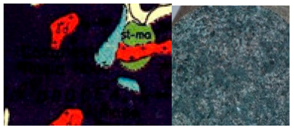 Gabbro with olivine and augite | Structure: holocrystalline, hypidiomorphic and allotriomorphic. Texture: unoriented (massive), compact. Mineralogical composition; basic plagioclase feldspar, augite, olivine, secondary minerals, saussurite. Basic plagioclase feldspar consists of the series of Labrador-bytownite-anortite, with 65% anortite. The plagioclase feldspar appears as medium and largely developed, presenting various stages of saussuritization alteration, respectively transformation into a fine aggregate consisting of zoisite, clinozoisite, epidote, albite, zeolites and sericite. Olivine (20%) is represented by hypidiomorphic, idiomorphic and allotriomorphic crystals, with dimensions between 1.5/0.5 mm and 0.5/0.1 mm. The mineral appears mostly fresh, where only the contourless olivine presents opacitization and serpentinization. Augite (8%) consists of hypidiomorphic and allotriomorphic crystals with dimensions below 1 mm. The cleavage is unidirectional for crystals sectioned parallel with Z crystallographic axis and bidirectional (89°) for crystals sectioned perpendicular on Z crystallographic axis. Opaque minerals are finely crystallized and non-uniformly dispersed into the rock mass. Denomination rock: Gabbro with olivine and slightly mineralized augite.  Basic plagioclase feldspar, olivine and augite, with geometric (idiomorphic) contour |
| Roșia Montană Rhyolite—sample number 6 Sampling location: Roșia Montană, Alba District. Geological structure: neogenic eruptivism, represented by rooted bodies, lava flows, explosive volcanic breccia and pyroclastics. Rock type: magmatic, neovolcanic effusive, acid. Rock structure: semicrystalline (hipocrystaline), porphyry–vitreous. Rock texture: unoriented (massive), compact. Color: white, slight gray hue. Mineralogical composition: potassium orthoclase feldspar, quartz, calco-sodic feldspar (plagioclase), volcanic glass, pyrite, argillite minerals, calcite. Reaction to acids: feldspar phenocryst, partially or totally calcified, presents a strong reaction with diluted HCl.  Rhyolite partially altered and mineralized | Structure: semicrystalline (hypocrystalline), porphyry-vitreous Texture: unoriented (massive), compact. Mineralogical composition; potassium orthoclase feldspar, quartz, plagioclase feldspar, main rock mass as volcanic glass and microlites, opaque minerals (pyrite), secondary minerals (argillite minerals, sericite and calcite). The orthoclase feldspar (50.4%), in most cases, appears as idiomorphic and hypidiomorphic crystals, sometimes with bi-synthetic macles (twins) and with various degrees of alteration. The crystals dimensions vary between 0.4 and 6 mm while the orthoclase, heavily argillized and substituted by calcite, contain idiomorphic and hypidiomorphic crystals of pyrite. Quartz (20.6%) presents laced and rounded contour due to the corroding of the volcanic glass. The quartz crystal dimensions do not exceed 5 mm. Plagioclase feldspar does not exceed 2% from the total mass of mineral components. This mineral appears partially to totally sericitized or calcified. The main rock mass, containing feldspars phenocryst and quartz, consists of microlites of orthoclase feldspar, submillimeter and rarely millimeter pyrite crystals and volcanic glass. Given the hydrothermal metamorphism, these minerals present a variety of alteration degrees. Pyrite, in most occurrences, appears finely crystalized (0.1 mm to 0.7 mm), rarely exceeding 1.5 mm. usually, the pyrite consists of solitary, idiomorphic and hypidiomorphic crystals, dispersed non-uniformly within the rock mass. Same pyrite can seldom appear as agglomerations of nests not exceeding dimensions of 5 mm. Denomination rock: Rhyolite, partially mineralized and altered.  Hypidiomorphic orthose with an incipient alteration stage and with sub millimeter pyrite inclusions |
| Valea Căpitanului Andesite—sample number 7 Sampling location: Certej–Hondol, Valea Căpitanului, Hunedoara District. Geologic structure: neogenic eruptivism of Apuseni Mountains (Metaliferi). Rock type: magmatic, effusive (neovolcanic), neutral. Rock structure: semicrystalline (hypocrystalline), porphyry-vitreous. Rock texture: unoriented (massive), compact. Color: gray, slightly dotted. Mineralogical composition: plagioclase feldspar, hornblende, microlitic paste. Reaction to acids: none of the rock components reacts with dilute HCl. 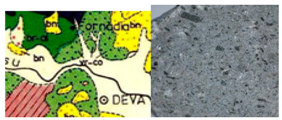 Andesite with hornblende | Structure: hypocrystalline, porphyry vitreous. Texture: unoriented (massive), compact. Mineralogical composition: neutral plagioclase feldspar, hornblende, microlites, volcanic glass, opaque minerals, secondary minerals. Plagioclase feldspar (32.5%) presents mostly idiomorphic and hypidiomorphic contours, rarely zoned. The crystals have variable dimensions, as follows: from 0.01 mm for microlites and 6.1/3.9 mm for phenocryst. Within the rock mass, the plagioclase feldspar exhibits various stages of alteration. Crystals with kaolinitized and sericitized contours, completely affected by the hydrothermal metamorphism, are also present. Hornblende (20.5%) appears within the rock mass as idiomorphic, hypidiomorphic and allotriomorphic crystals, with dimensions between 0.2/0.07 mm and 8.1/1.2 mm. Crystals sectioned parallel with crystallographic axis Z present good unidirectional cleavage, while the ones sectioned perpendicular to the same axis have clearly defined bidirectional cleavage (124°). Some amphibolite crystals exhibit partial or total opacitization. Opaque minerals (8.5%) consist of idiomorphic, hypidiomorphic and xenomorphic pyrite crystals, non-uniformly distributed within the main rock mass (microlitic and glassy, at 44.5%). Denomination rock: Andesite with hornblende  Plagioclase feldspar, idiomorphic with completely altered contours (Kaolinitized and sericitized) |
| Dealul Motor Andesite—sample number 8 Sample location: Deva, Motor Hill, Hunedoara District. Geologic structure: neogenic eruptivism from Mures Valley. Rock type: magmatic, effusive (neovolcanic), neutral. Structure: semicrystalline, porphyry vitreous Texture: unoriented (massive), compact. Color: gray. Mineralogical composition: neutral plagioclase feldspar, hornblende, rarely biotite lamellae and microlitic paste. Reaction to acids: slight reaction with diluted HCl, due to presence of calcite formed on plagioclase and hornblende. 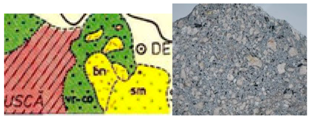 Andesite with hornblende and biotite | Structure: hypocrystalline, porphyry vitreous. Texture: unoriented (massive), compact. Mineralogical composition: plagioclase feldspar, hornblende, biotite, microlitic paste, opaque minerals, kaolinite, sericite, chlorite, limonite. Plagioclase feldspar (24.5%) presents mostly idiomorphic contours, also zoned. Crystal dimensions are variable, from 0.01 mm in microlites up to 6.1/4.5 mm for phenocryst. The cleavage appears distinct for crystals sectioned parallel to crystallographic axis Z. Hornblende (12.5%), similar to the plagioclase feldspar, appears predominantly idiomorphic. The hornblende crystals are sectioned perpendicular to crystallographic axis Z (basal sections) and parallel to same axis (elongated, prismatic sections). In both cases, good cleavage appears distinctly, bidirectional (124°) at basal sections and unidirectional for sections parallel with prismatic faces. Some crystals with idiomorphic contours exhibit partial or total opacitization. Biotite does not exceed 0.6% from all rock mass components and appears generally fresh, sometimes with incipient chloritization and limonitization. Some biotite lamellae, along the unidirectional cleavage, present slight opacitization. Opaque and secondary minerals do not exceed 3.5% of all rock mass components and consists of fine magnetite crystals, either as inclusions within phenocryst or irregularly distributed within the rock mass. Pulverulent kaolinite and finely lamellae of sericite appear on some plagioclase crystals or within the paste. The finely crystallized calcite appears with some plagioclase feldspars richer in anortite and sporadically with hornblende. Denomination rock: Andesite with hornblende and biotite.  Zoned plagioclase feldspar, with unaltered peripheral zones and central zones partially sericitized-kaolinitized, with biotite inclusions partially resorbed |
| Criscior Andesite—sample number 9 Sampling location: Criscior, Hunedoara district. Geologic structure: tardive subsequent magmatism (neogenic), second cycle. Rock type: magmatic, effusive (neovolcanic), neutral. Structure: semi-crystalline (hypocrystalline), porphyry-vitreous. Texture: unoriented (massive), compact. Color: dark gray. Mineralogical composition: plagioclase feldspar, hornblende, vitreous-microlitic paste, secondary minerals. Reaction to acids: none of the rock components reacts with dilute HCl 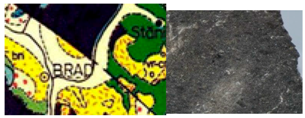 Vitro-porphyry Andesite | Structure: hypocrystalline, porphyry-vitreous Texture: unoriented (massive), compact. Mineralogical composition: neutral plagioclase feldspar, hornblende, microlitic vitreous paste, opaque minerals, secondary minerals (kaolinite, sericite, limonite). Plagioclase feldspar (30.5%) is represented by idiomorphic and hipidiomorphic crystals with incipient alteration stages. The plagioclase feldspar appears mostly zoned, with crystals dimensions varying between 0.3/0.2 mm and 2.0/1.0 mm. Central zones of the plagioclase feldspar, with higher anortite content, appear sometimes transformed into kaolinite and sericite. For most of the cases, the microlitic plagioclase feldspar appears not-altered. Hornblende (4.5%) appears with the rock mass as hipidiomorphic crystals, with dimensions below 1 mm. For most of the cases, the crystals contours are opacitized; sometimes, the amphibole is completely transformed into a secondary product through oxy-hydration. The vitreous-microlitic paste (55%) in this rock type consists of amorphous volcanic glass, where the feldspars microlites appear non-uniformly distributed. As the feldspars, microlites are predominant, the resulting macroscopic color is dark gray. Denomination rock: Vitreous-porphyry Andesite.  Idiomorphic zoned plagioclase feldspar, centrally altered and with non-altered, clear, periphery contours. Two joint hypidiomorphic plagioclase crystals |
| Săcărâmb Andesite—sample number 10 Sample location: Săcărâmb, Hunedoara District. Geologic structure: neogenic eruptivism of Apuseni Mountains (Metaliferi), second cycle. Rock type: magmatic, effusive (neovolcanic), intermediary. Structure: hypocrystalline (semicrystalline), porphyry vitreous. Texture: unoriented (massive), compact. Color: grey, slightly dotted. Mineralogical composition: plagioclase feldspar, hornblende, vitreous microlitic paste, secondary minerals. Reaction to acids: none of the rock components reacts with dilute HCl. 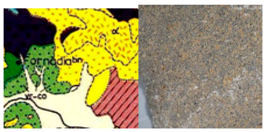 Andesite with hornblende, partially altered | Structure: semicrystalline, porphyry vitreous. Texture: unoriented (massive), compact. Mineralogical composition: neutral plagioclase feldspar, hornblende, vitreous microlitic paste, secondary and opaque minerals. Plagioclase feldspar (25.5%) consists of idiomorphic and hipidiomorphic crystals exhibiting different stages of kaolinization and sericitization. The anortite content, partially or totally altered, appears more frequently within the central zones, as opposed to the outer layer which appears usually fresh, without any transformation into kaolinite and sericite. Plagioclase feldspar crystal dimensions vary between 0.2/0.1 mm and 5.0/3.8 mm. Hornblende (8.3%) appears within the rock mass as idiomorphic and hipidiomorphic crystals, some unaltered, some partially or totally sericitized. Good cleavage, bidirectional for basal sections, is observed; unidirectional cleavage characteristic for longitudinal sections appears either distinct or completely opacitized. The microlitic and vitreous paste presents an advanced grade of alteration into kaolinite and sericite. Fresh microlites are rare and belong to the same type of plagioclase feldspar. Opaque minerals (2%) consist of submillimeter crystals of pyrite and chalcopyrite, not exceeding dimensions of 1.7 mm. These crystals are non-uniformly distributed within the rock mass. Denomination rock: Andesite with hornblende partially altered.  Plagioclase feldspars partially altered, with non - transformed crystals contours, welded crystals of plagioclase and opacitized idiomorphic hornblende, idiomorphic and hypidiomorphic submillimeter pyrite |
| Albinii-Haneș Andesite—sample number 11 Sample location: Albinii-Haneș, Alba District. Geologic structure: neogenic eruptivism of Apuseni Mountains (Metaliferi). Rock type: magmatic, effusive (neovolcanic), intermediary. Structure: hypocrystalline (semicrystalline), porphyry vitreous. Texture: unoriented (massive), compact. Color: grey, slightly dotted. Mineralogical composition: plagioclase feldspar, hornblende, microlitic paste. Reaction to acids: none of the rock components reacts with dilute HCl.  Andesite with hornblende | Structure: semicrystalline, porphyry vitreous. Texture: unoriented (massive), compact. Mineralogical composition: neutral plagioclase feldspar, hornblende, microlitic, volcanic glass, secondary and opaque minerals. Plagioclase feldspar (23.8%) consists mostly of idiomorphic and hypidiomorphic crystals, rarely zoned. Plagioclase feldspar crystal dimensions vary from 0.01 mm for microlites and 6.2/4.3 mm for phenocryst. For thin sections parallel with crystallographic axis Z and presenting polysynthetic macles (twins), the unidirectional cleavage appears distinctly. Hornblende (12.6%) appears within the rock mass as idiomorphic, hypidiomorphic and xenomorphic crystals with dimensions between 0.2/0.08 mm and 10.3/1 mm. The sections are either parallel or perpendicular on crystallographic axis Z. Good cleavage appears distinctly, as bidirectional (124°) or basal sections and unidirectional for sections parallel with prismatic faces. Some of the idiomorphic and hypidiomorphic crystals present partial or total opacitization. Microlites (50%) are feldspathic, non-uniformly distributed within the volcanic glass. Opaque minerals (4.5%) are finely crystalized, idiomorphic, hipidiomorphic and xenomorphic, chaotically distributed within the rock paste and consisting of pyrite and oxidic minerals. Secondary minerals, represented by kaolinite, affect partially some plagioclase phenocrysts and microlites. Denomination rock: Andesite with hornblende.  Millimeter idiomorphic crystal of hornblende, with opacitized contour |
| Roșia Poieni Andesite—sample number 12 Sample location: Rosia Poieni, Alba District. Geologic structure: neogenic eruptivism (second cycle), represented by rooted structures, lava flows and andesitic pyroclastics. Rock type: magmatic, neovolcanic, neutral (intermediary). Structure: hypocrystalline (semicrystalline), porphyry vitreous. Texture: unoriented (massive), compact. Color: grey, dotted. Mineralogical composition: plagioclase feldspar, hornblende, calcite, pyrite. Reaction to acids: calcite deposited at a later stage along fissures reacts strongly with diluted HCl.  Poieni hornblendic andesite | Structure: semicrystalline (hypocrystalline), porphyry vitreous. Texture: unoriented (massive), compact. Mineralogical composition: neutral plagioclase feldspar, hornblende, microlitic vitreous paste, kaolinite, sericite, calcite, pyrite. Plagioclase feldspar (chalco-sodic) (20.5%) consists of idiomorphic and hipidiomorphic crystals, rarely allotriomorphic, with dimensions between 0.4/0.2–6.2/3.2 mm. In several instances, the plagioclase feldspar appears zoned, with an incipient alteration stage (sercitization and kaolinitization). Hornblende (14.3%) appears as the common variety (green) and consists of prismatic crystals (idiomorphic and hipidiomorphic) with dimensions between 0.6/2.5–0.1/0.7 mm. In most cases, hornblende appears partially or totally opacitized. Kaolinite and sericite, as secondary products, appear in smaller percentages in some plagioclase feldspar crystals, as well as in the rock’s paste, along with microcrystalline pyrite. Calcite was deposited at a later stage along the micro fissures and contraction fissures found within the rock mass. The microlitic paste (55.2%) is represented by feldspar and volcanic glass. Denomination rock: Poieni hornblendic andesite  Plagioclase phenocryst, zoned and with peripheral alteration |
| Căzănești Diabase—sample number 13 Sample location: Căzănești, Drocea Mountains, Hunedoara district. Geologic structure: initial eruptivism Rock type: magmatic, effusive, paleovolcanic. Structure: devitrified, ophitic. Texture: unoriented (massive), compact. The rock presents a system of millimeter fissures, colmated with carbonates and pyrite. Color: grey, slightly green hue. Mineralogical composition: plagioclase feldspar, pyroxene, carbonates, pyrite, secondary minerals, dolomitic limestone enclaves. Reaction to acids: calcite (CaCO3) reacts strongly with diluted HCl.  Mid-ophytic diabase partially altered and mineralized | Structure: mid-ophytic Texture: unoriented (massive), compact. Mineralogical composition: plagioclase feldspar, augite, olivine, calcite, dolomite, pyrite, chlorite, serpentine. Basic plagioclase feldspar (58.5%), initially basic (anortitic), in the majority of cases partially albitized, is represented by idiomorphic crystals with dimensions between 0.2/0.09 mm and 0.05/0.03 mm. The plagioclase from the fundamental rock mass is completely transformed into kaolinite, calcite and magnesium. Augite and olivine (22%) consist of allotriomorphic submillimeter crystals, grown into the interstitials between the intersected prismatic plagioclase crystals. Most of these minerals are transformed into chlorite, bastite and serpentinitic minerals. Calcite, dolomite and pyrite (15%) have hydrothermal origin, with very fine crystallization, deposited at a later stage on the contraction fissures of the diabasic lava. Denomination rock: Medio-ophitic diabase, partially altered and mineralized.  Diabase with ophitic structure, medium-crystalized and albitised plagioclase (spilitized) |
| Brănișca Basalt—proba 14 Sample location: Branisca, Hunedoara district. Geologic structure: Mures valley Neogene eruptivism. Rock type: magmatic, effusive (neovolcanic), basic. Structure: hypocrystalline, porphyry intersertal. Texture: compact, partially vacuolar, unoriented and oriented (fluidal). Color: dark grey. Mineralogical composition: plagioclase feldspar, pyroxene, olivine. Reaction to acids: none of the rock components reacts with dilute HCl.  Dark Grey basalt, Branisca type | Structure: semicrystalline, porphyry intersertal. Texture: unoriented (massive), compact and oriented (fluidal), partially vacuolar. Mineralogical composition: neutral and basic plagioclase feldspar, olivine, pyroxene, opaque minerals, alteration minerals (sericite, bowlingite). Plagioclase feldspars are predominant (75.3%), represented by two types of crystals; crystal dimensions vary between 0.5/0.1 mm and 0.3/0.04 mm, while the predominant microlites vary between 0.1/0.03–0.05/0.01 mm. Basic plagioclase (calcic) appears from fresh to partially or totally replaced by calcite. Olivine does not exceed 2% from all rock mass components. The olivine hipidiomorphic and allotriomorphic crystals have submillimeter dimensions, respectively 0.75/0.35–0.25/0.15 mm. The olivine presents an advanced state of alteration, along with formation of secondary minerals, such as bowlingite and asbestos. Pyroxenes are represented by idiomorphic and hipidiomorphic crystals, constituting less than 1% from the total minerals components. Pyroxene is represented by fresh augite. Opaque minerals, with submillimeter dimensions (0.03–0.04 mm) are also found in the rock mass (paste). Denomination rock: Dark gray basalt, Branisca type  Idiomorphic augite, non-altered and with fluidal rock texture |
| Dobra Basalt—sample number 15 Sample location: Dobra, Hunedoara district. Geologic structure: Mures Valley Neogenic eruptivism (basaltic pyroclastics pyroclastics, post Sarmatian age). Rock type: magmatic, effusive (neovolcanic), basic. Structure: hypocrystalline, porphyry intersertal. Texture: unoriented (massive), compact. Color: dark grey. Mineralogical composition: plagioclase feldspar, olivine, secondary minerals. Reaction to acids: none of the rock components reacts with dilute HCl.  Olivinic basalt, Dobra type | Structure: semicrystalline (hipocrystaline), porphyry intersertal. Texture: compact, non-oriented. Mineralogical composition: basic and partially neutral plagioclase feldspar, olivine, augite, volcanic glass, opaque minerals, secondary minerals. Plagioclase feldspars (73.4%) consist, according to their dimensions, of phenocryst (0.6/0.2 mm and 0.4/0.05 mm) and microlites (0.1/0.02–0.04/0.01 mm). Plagioclase feldspars appear fresh, as idiomorphic and hipidiomorphic crystals, chaotically spread within the rock mass. Olivine does not exceed 3.5% of rock mass and is represented by the varieties forsterite and fayalite. Forsterite, a magnesian olivine, appears fresh, as idiomorphic, hipidiomorphic and xenomorphic crystals, with dimensions between 1.5/0.8 mm and 0.4/0.2 mm. The forsterite presents conchoidal breakage and imperfect cleavage. Fayalite, feriferic olivine, with submillimeter dimensions, appears partially to totally altered (opacitized). Augite is rarely encountered, partially altered, with submillimeter dimensions. Opaque minerals, with dimensions between 0.03–0.06 mm, appear in the rock mass and in some olivine crystals. Denomination rock: Olivinitic basalt Dobra Type  Olivine phenocryst (fayalite), strongly fissured |
| Rock Type | Sampling Location | Sc (mmol/dm3) | Rc (mmol/dm3) |
|---|---|---|---|
| Andesite | Certej Valea Căpitanului | 51 | 19.4 |
| Andesite | Deva Dealul Motor | 53.4 | 21.6 |
| Andesite | Crișcior | 53.5 | 22.7 |
| Andesite | Săcărâmb | 55.4 | 23.4 |
| Andesite | Albinii (Haneş) | 51.3 | 16.9 |
| Andesite | Roşia Poieni | 49.3 | 19.1 |
| Basalt | Brănişca | 6.5 | 19 |
| Basalt | Dobra | 6.3 | 21 |
| Class | Rock and Aggregate Characterization Relative to Sc (mmol/dm3) and Rc (mmol/dm3) |
|---|---|
| A | Unreactive |
| B | Generally unreactive |
| C | Potential significant reactivity |
| D | Harmful |
| Sample Number | Rock Type | Physical Characteristics | |||||
|---|---|---|---|---|---|---|---|
| Specific Density ρ·103 (kg/m3) | Apparent Density ρa·103 (kg/m3) | Porosity n (%) | Compaction C (%) | Natural Moisture W (%) | Water Absorption at Normal Pressure, ai (%) | ||
| 1 | Gabbro | 2.8887 | 2.8449 | 1.5162 | 98.4837 | 0.2271 | 0.4274 |
| 2 | Diabase | 2.7852 | 2.7499 | 1.2673 | 98.7326 | 0.3922 | 0.6951 |
| 3 | Granite | 2.6350 | 2.6195 | 0.5881 | 99.4117 | 0.1463 | 0.3193 |
| 4 | Granite | 2.6458 | 2.6240 | 0.8225 | 99.1773 | 0.1227 | 0.2988 |
| 5 | Granite | 2.6455 | 2.6254 | 0.7597 | 99.2401 | 0.1488 | 0.3144 |
| 6 | Diorite | 2.9648 | 2.9513 | 0.4564 | 99.5434 | 0.1867 | 0.3625 |
| 7 | Rhyolite | 2.6490 | 2.5667 | 3.1042 | 96.8957 | 1.9273 | 2.6834 |
| 8 | Andesite | 2.7712 | 2.6682 | 3.7167 | 96.2831 | 0.9595 | 1.6190 |
| 9 | Andesite | 2.7325 | 2.6129 | 4.3744 | 95.6254 | 1.0867 | 1.6690 |
| 10 | Andesite | 2.6558 | 2.6397 | 0.6061 | 99.3937 | 0.7963 | 1.4089 |
| 11 | Andesite | 2.6515 | 2.4574 | 7.3201 | 92.6797 | 2.7668 | 3.4895 |
| 12 | Andesite | 2.6931 | 2.6734 | 0.7339 | 99.2660 | 0.6404 | 1.1652 |
| 13 | Andesite | 2.7124 | 2.6440 | 2.5229 | 97.4769 | 1.1630 | 1.9805 |
| 14 | Basalt | 2.7289 | 2.7046 | 0.8916 | 99.1082 | 0.7758 | 1.2342 |
| 15 | Basalt | 2.7248 | 2.6994 | 0.9309 | 99.0689 | 0.9018 | 1.3361 |
| ID | Rock Type | Resistance Characteristics | |||||
|---|---|---|---|---|---|---|---|
| Breaking Resistance at Uniaxial Compression (MPa) | Abrasion of Aggregate by Los Angeles Machine (%) | Shattering Caused by Compression in Dry State (%) | Freezing–Thawing Resistance | ||||
| Dry State | After 25 Cycles Freezing–Thawing | Gelivity Coefficient (%) | Freezing Sensitivity (%) | ||||
| 1 | Gabbro | 150.173 | 124.644 | 12.204 | 95.083 | 0.022 | 16.942 |
| 2 | Diabase | 161.117 | 129.017 | 15.815 | 93.760 | 0.033 | 19.882 |
| 3 | Granite | 172.189 | 158.055 | 11.15 | 95.855 | 0.005 | 8.142 |
| 4 | Granite | 212.220 | 192.615 | 11.820 | 96.226 | 0.008 | 9.154 |
| 5 | Granite | 168.488 | 156.272 | 10.161 | 95.799 | 0.011 | 7.237 |
| 6 | Diorite | 183.860 | 171.727 | 10.44 | 94.936 | 0.015 | 6.608 |
| 7 | Rhyolite | 122.997 | 85.731 | 23.907 | 88.797 | 0.110 | 29.919 |
| 8 | Andesite | 110.194 | 91.039 | 12.753 | 88.540 | 0.136 | 17.383 |
| 9 | Andesite | 131.934 | 105.181 | 16.877 | 90.078 | 0.255 | 20.234 |
| 10 | Andesite | 143.538 | 125.297 | 16.369 | 92.016 | 0.127 | 12.715 |
| 11 | Andesite | 123.674 | 94.235 | 20.052 | 85.367 | 0.270 | 23.819 |
| 12 | Andesite | 142.404 | 122.420 | 11.138 | 92.492 | 0.113 | 13.997 |
| 13 | Andesite | 129.632 | 103.753 | 15.4 | 91.694 | 0.130 | 19.949 |
| 14 | Basalt | 170.839 | 157.856 | 13.724 | 95.951 | 0.057 | 7.619 |
| 15 | Basalt | 179.586 | 166.613 | 14.825 | 93.111 | 0.075 | 7.187 |
| Characteristics | Rock Class 1 | Lab. Method | |||||
|---|---|---|---|---|---|---|---|
| A | B | C | D | E | |||
| Admissibility Conditions | |||||||
| Apparent porosity at normal pressure, %, max. | 1 | 3 | 5 | 8 | 10 | STAS 6200/13 | |
| Compression resistance in dry state, MPa, min. | 160 | 140 | 120 | 100 | 80 | STAS 6200/5 | |
| Abrasion by Los Angeles machine, %, max. | 16 | 18 | 22 | 25 | 30 | STAS 730 | |
| Shattering caused by compression in dry state, %, min. | 70 | 67 | 65 | 60 | 50 | STAS 730 | |
| Freezing–thawing resistance: | Gelivity coefficient (μ25), %, max. | 3 | STAS 730 | ||||
| Freezing sensitivity (ηd25), %, max. | 25 | ||||||
| N° | Indicator (Characteristic of Rock) | Rock Type | Rock Class | Points Rated | ||||
|---|---|---|---|---|---|---|---|---|
| A | B | C | D | E | ||||
| Gabbro | Points Rating | |||||||
| 5 | 4 | 3 | 2 | 1 | ||||
| 1 | Apparent porosity at normal pressure, % | 1.516 | x | 4 | ||||
| 2 | Compression resistance in dry state, N/mm2 | 150.173 | x | 4 | ||||
| 3 | Abrasion by Los Angeles machine, % | 12.204 | x | 5 | ||||
| 4 | Shattering caused by compression in dry state, % | 77.326 | x | 5 | ||||
| 5 | Gelivity coefficient, % | 0.022 | x | 5 | ||||
| 6 | Freezing sensitivity, % | 16.942 | x | 4 | ||||
| Total points assigned to the indicators rated 5 | A | 15 | ||||||
| Total points assigned to the indicators rated 4 | B | 12 | ||||||
| Total points assigned to the indicators rated 3 | C | 0 | ||||||
| Total points assigned to the indicators rated 2 | D | 0 | ||||||
| Total points assigned to the indicators rated 1 | E | 0 | ||||||
| Number of applicable indicators with percentage 5 | f | 3 | ||||||
| Number of applicable indicators with percentage 4 | g | 3 | ||||||
| Number of applicable indicators with percentage 3 | h | 0 | ||||||
| Number of applicable indicators with percentage 2 | i | 0 | ||||||
| Number of applicable indicators with percentage 1 | j | 0 | ||||||
| Obtained Points: PO = A + B + C + D + E | PO | 27 | ||||||
| Maximum Points: PM = 5 (f + g + h + i + j) | PM | 30 | ||||||
| Conformity Level, % | NC | 90.00 | ||||||
| Obtained Points: PO’ = 5A + 4B + 3C + 2D + E | PO’ | 123 | ||||||
| Maximum Points: PM’ = 5 (5f + 4g + 3h + 2i + j) | PM’ | 140 | ||||||
| Safety Level % | NS | 87.8571 | ||||||
| Unconformity Degree % | GC | 10.00 | ||||||
| Level of Safety (%) | Risk of Use the Rock |
|---|---|
| 91–100 (very high) | Very low risk |
| 81–90 (high) | Low risk |
| 61–80 (medium) | Medium risk |
| 40–60 (low) | High risk |
| <40 (very low) | Very high risk |
| Conformity Level, NC (%) | Unconformity Degree (%) |
|---|---|
| 80–100 (very high) | Very low |
| 60–80 (high) | Low |
| 40–60 (medium) | Medium |
| 20–40 (low) | High |
| <20 (very low) | Very high |
| Type of Rock | Conformity Level | Obtained Points | Maximum Points | Safety Level | Unconformity Degree |
|---|---|---|---|---|---|
| Gabbro (Căzăneşti) | 90.00 | 123 | 140 | 87.8571 | 10.00 |
| Granit (F31) | 83.3333 | 125 | 150 | 83.3333 | 16.6667 |
| Diabaz (Căzăneşti) | 93.3333 | 132 | 140 | 94.2857 | 6.6667 |
| Granit (F21) | 96.6667 | 141 | 150 | 94.00 | 3.3333 |
| Granit (Săvârşin) | 96.6667 | 141 | 150 | 94.00 | 3.3333 |
| Diorite | 96.6667 | 141 | 150 | 94.00 | 3.3333 |
| Rhyolite (Roşia Montană) | 56.6667 | 53 | 150 | 35.3333 | 43.3333 |
| Andesite (Certej) | 80.00 | 100 | 150 | 66.6667 | 20.00 |
| Andesite (Deva) | 60.00 | 58 | 150 | 38.6667 | 40.00 |
| Andesite (Brad) | 86.6667 | 116 | 150 | 77.3333 | 13.3333 |
| Andesite (Săcărâmb) | 46.6667 | 38 | 150 | 25.3333 | 53.3333 |
| Andesite (Haneş) | 90.00 | 125 | 150 | 83.3333 | 10.00 |
| Andesite (Roşia Poieni) | 76.6667 | 95 | 150 | 63.3333 | 23.3333 |
| Basalt (Brănişca) | 96.6667 | 141 | 150 | 94.00 | 3.3333 |
| Basalt (Dobra) | 96.6667 | 141 | 150 | 94.00 | 3.3333 |
| Rock Type | Rock Class | Apparent Porosity at Normal Pressure (max.) (%) | Compression Resistance in Dry State (min.), (N/mm2) | Abrasion by Los Angeles Machine (max.) (%) | Shattering Caused by Compression in Dry State (min.) (%) | Freezing–Thawing Resistance | |
|---|---|---|---|---|---|---|---|
| Gelivity Coefficient (max.) (%) | Freezing Sensitivity (max.) (%) | ||||||
| Gabbro | B | 1.516 | 150.17 | 12.204 | 77.326 | 0.022 | 16.942 |
| Granite | A | 0.588 | 172.189 | 11.150 | 76.888 | 0.005 | 8.142 |
| Diabase | B | 1.267 | 161.117 | 15.815 | 75.338 | 0.033 | 19.882 |
| Granite | A | 0.822 | 212.220 | 11.820 | 78.176 | 0.008 | 9.154 |
| Granite | A | 0.754 | 168.488 | 10.161 | 75.530 | 0.011 | 7.237 |
| Diorite | A | 0.456 | 183.860 | 10.440 | 78.873 | 0.015 | 6.608 |
| Rhyolite | D | 3.104 | 122.997 | 23.907 | 64.321 | 0.110 | 29.919 |
| Andesite | C | 3.716 | 110.194 | 12.753 | 70.521 | 0.136 | 17.383 |
| Andesite | C | 4.374 | 131.934 | 16.877 | 62.162 | 0.255 | 20.234 |
| Andesite | B | 0.606 | 143.538 | 16.369 | 72.014 | 0.127 | 12.715 |
| Andesite | D | 7.320 | 123.674 | 20.052 | 66.261 | 0.270 | 23.819 |
| Andesite | A | 0.733 | 142.404 | 11.138 | 72.615 | 0.113 | 13.997 |
| Andesite | B | 2.522 | 129.632 | 15.400 | 69.354 | 0.130 | 19.949 |
| Basalt | A | 0.891 | 170.839 | 13.724 | 74.061 | 0.057 | 7.619 |
| Basalt | A | 0.930 | 179.586 | 14.825 | 72.885 | 0.075 | 7.187 |
© 2017 by the authors. Licensee MDPI, Basel, Switzerland. This article is an open access article distributed under the terms and conditions of the Creative Commons Attribution (CC BY) license (http://creativecommons.org/licenses/by/4.0/).
Share and Cite
Toderaş, M.; Moraru, R.I.; Danciu, C.; Buia, G.; Cioca, L.-I. Model to Assess the Quality of Magmatic Rocks for Reliable and Sustainable Constructions. Sustainability 2017, 9, 1925. https://doi.org/10.3390/su9101925
Toderaş M, Moraru RI, Danciu C, Buia G, Cioca L-I. Model to Assess the Quality of Magmatic Rocks for Reliable and Sustainable Constructions. Sustainability. 2017; 9(10):1925. https://doi.org/10.3390/su9101925
Chicago/Turabian StyleToderaş, Mihaela, Roland Iosif Moraru, Ciprian Danciu, Grigore Buia, and Lucian-Ionel Cioca. 2017. "Model to Assess the Quality of Magmatic Rocks for Reliable and Sustainable Constructions" Sustainability 9, no. 10: 1925. https://doi.org/10.3390/su9101925
APA StyleToderaş, M., Moraru, R. I., Danciu, C., Buia, G., & Cioca, L.-I. (2017). Model to Assess the Quality of Magmatic Rocks for Reliable and Sustainable Constructions. Sustainability, 9(10), 1925. https://doi.org/10.3390/su9101925






